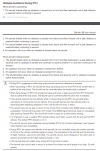A couple of things I would suggest,
1) An unneccessarily high RTH height is unwise. Assuming the drone has to climb to RTH height it wastes power in both the climb and the descent and, at somepoint, that may be critical.
Whilst it wasn't critical, I have experienced a too high RTH setting, way WAY too high, an accidental setting that went unnoticed until it was too late. It was during a disconnection RTH. It can take a loonngg time to get a drone down from height lol. Excess height may also put the drone up into high wind, (I was very lucky that day). With the
Mini 3 this is not as great a concern as it was with the Mavic Mini but it is, arguably, not a good idea.
2) The RTH height can not exceed the maximum height, the App wont allow it. I experimented with this a while back.
If the maxiumum height limit is reduce to below the RTH height, the RTH height setting will be automatically reduced, by the App, to the maximum height setting. If the drone is above the new maximum height then the control system will reduce the drone's height to match the new maximum height setting.
You might like to have a look at DJI Wanda's post, no 6, in the thread
A question for DJI. With drones that have obstacle avoidance that...











